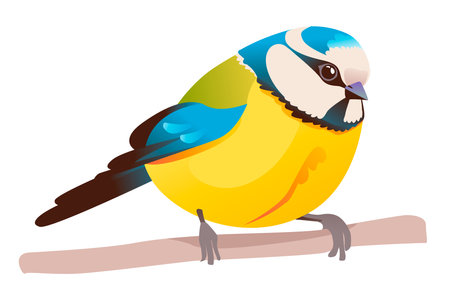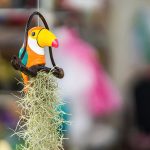1. Introduction to Hawk-Headed Parrots
Hawk-headed parrots, also known as red-fan parrots (Deroptyus accipitrinus), are one of the most unique and fascinating parrot species. These birds stand out due to their striking appearance, distinctive personality, and intriguing behaviors. Unlike many other parrots, they have a remarkable ability to raise the feathers around their head, creating a fan-like display that resembles a hawk, hence their name.
Appearance and Physical Characteristics
The hawk-headed parrot has a stunning combination of colors that make it truly eye-catching. Below is an overview of their physical traits:
| Feature | Description |
|---|---|
| Size | Around 12-14 inches (30-35 cm) in length |
| Weight | Approximately 8-10 ounces (225-280 grams) |
| Main Colors | A mix of green, blue, and brown with a striking red and blue fan-like crest |
| Crest Feature | A unique feather display that fans out when excited or threatened |
| Lifespan | Can live up to 30 years or more with proper care |
Natural Habitat and Distribution
This species is native to the Amazon rainforest, primarily found in countries such as Brazil, Colombia, Ecuador, Peru, and Venezuela. They thrive in dense forests where they can find plenty of food sources like fruits, seeds, and nuts. Their natural environment plays a crucial role in shaping their behavior and dietary needs.
What Makes Them Unique?
The hawk-headed parrot is unlike any other parrot species due to its highly independent yet affectionate nature. While they can form strong bonds with their owners, they also enjoy having personal space. Their playful but sometimes moody temperament makes them best suited for experienced bird owners who understand the complexities of parrot behavior.
Main Personality Traits:
- Clever and Curious: They love exploring their surroundings and engaging in problem-solving activities.
- Mood-Sensitive: Their behavior can shift quickly from playful to reserved.
- Loyal but Independent: They form close bonds but appreciate alone time.
- Noisy Communicators: While not as loud as some other parrots, they can be quite vocal when excited.
If you’re considering bringing a hawk-headed parrot into your home, understanding these unique traits is essential. They require patience, respect for their independence, and plenty of mental stimulation to thrive in captivity.
2. Understanding Their Personality and Behavior
Hawk-headed parrots are truly unique birds with personalities that set them apart from other parrot species. Their intelligence, mood swings, and social behaviors make them fascinating companions, but they also require patience and understanding from their owners. By learning about these traits, you can build a strong bond with your feathered friend.
Intelligence: A Smart and Curious Companion
Hawk-headed parrots are highly intelligent birds that love to explore their environment. They enjoy solving puzzles, learning tricks, and even mimicking sounds or words. To keep them mentally stimulated, provide interactive toys, training sessions, and plenty of challenges.
Ways to Stimulate Your Hawk-Headed Parrot’s Intelligence
| Activity | Description |
|---|---|
| Puzzle Toys | Provide toys that require problem-solving, like treat-dispensing puzzles. |
| Training Sessions | Teach commands or tricks using positive reinforcement techniques. |
| Mimicry Practice | Encourage your parrot to imitate sounds or words by repeating them often. |
| New Experiences | Introduce new objects and environments to keep their curiosity engaged. |
Mood Swings: Understanding Their Emotional Shifts
This species is known for its mood swings. One moment they might be affectionate and playful, while the next they could become independent or even defensive. It’s important to respect their boundaries and recognize when they need space.
Signs of Different Moods in Hawk-Headed Parrots
| Mood | Behavioral Signs |
|---|---|
| Happy & Playful | Singing, playing with toys, eager for interaction. |
| Irritated or Overwhelmed | Puffing up feathers, avoiding contact, vocalizing loudly. |
| Cautious or Nervous | Eying surroundings carefully, slow movements. |
| Aggressive or Defensive | Lunging, biting attempts, fluffing head feathers as a warning sign. |
Social Behavior: Building a Strong Bond
Hawk-headed parrots are social creatures but can also be independent at times. They form strong bonds with their owners and thrive on interaction. However, they may not always seek attention like some other parrot species do. Respecting their personality while offering consistent companionship is key to forming trust.
Tips for Strengthening Your Bond with Your Parrot
- Create a Routine: Establish regular feeding and playtime schedules to help them feel secure.
- Respect Their Space: Give them time alone when needed without forcing interaction.
- Use Positive Reinforcement: Reward good behavior with treats and praise instead of punishing bad behavior.
- Spend Quality Time Together: Engage in activities like training or gentle petting to build trust.
- Avoid Sudden Changes: Introduce new people or changes in environment gradually to prevent stress.
The more you understand your hawk-headed parrot’s personality, the better you can care for them and strengthen your relationship. By recognizing their intelligence, handling mood swings appropriately, and respecting their social nature, you’ll create a happy and fulfilling companionship with your bird.

3. Proper Nutrition and Diet
Providing a well-balanced diet is essential for keeping your hawk-headed parrot healthy and active. These intelligent and energetic birds require a diverse range of nutrients to support their unique personalities and overall well-being. A proper diet consists of high-quality pellets, fresh fruits, vegetables, and occasional treats.
Recommended Diet for Hawk-Headed Parrots
A balanced diet should include a combination of the following food groups:
| Food Type | Examples | Feeding Frequency |
|---|---|---|
| Pellets | High-quality parrot pellets (free from artificial additives) | Daily (70% of diet) |
| Fresh Fruits | Apples, bananas, mangoes, papayas, berries | Several times per week (15% of diet) |
| Vegetables | Carrots, bell peppers, leafy greens, sweet potatoes | Several times per week (10% of diet) |
| Treats & Nuts | Almonds, walnuts, seeds (in moderation) | Occasionally (5% of diet) |
Fruits and Vegetables: Essential Nutrients
Fresh fruits and vegetables provide essential vitamins and minerals that support your parrots immune system and feather health. Always wash produce thoroughly before serving, and remove any seeds or pits that may be toxic, such as those found in apples or cherries.
Safe Fruits for Your Parrot
- Mangoes – Rich in vitamin A for feather health
- Berries – High in antioxidants to boost immunity
- Papayas – Supports digestion with natural enzymes
- Bananas – Provides energy with natural sugars
- Apples (seedless) – A great source of fiber
Nutritious Vegetables to Include
- Carrots – High in beta-carotene for eye health
- Kale – Packed with calcium for strong bones
- Bell Peppers – Rich in vitamin C for immune support
- Zucchini – Hydrating and easy to digest
- Sweet Potatoes – Provides complex carbohydrates for energy
Avoid Harmful Foods
Certain foods can be toxic or harmful to hawk-headed parrots. Avoid feeding them the following:
- Avocados – Contains persin, which is toxic to birds.
- Chocolate & Caffeine – Can cause heart issues and toxicity.
- Dairy Products – Birds cannot digest lactose properly.
- Sugary or Salty Foods – Can lead to obesity and health problems.
- Onions & Garlic – May cause digestive issues and toxicity.
The Importance of Fresh Water
Your parrot should always have access to clean, fresh water. Change their water at least once a day to prevent contamination. If possible, use filtered or dechlorinated water to avoid any harmful chemicals that may be present in tap water.
Treats: Rewarding Without Overfeeding
Treats are a great way to bond with your parrot and reinforce positive behaviors. However, they should be given in moderation. Nuts and seeds can be offered occasionally but should not replace essential nutrients from pellets, fruits, and vegetables.
A well-balanced diet plays a crucial role in maintaining the vibrant personality and long-term health of your hawk-headed parrot. By providing nutritious meals tailored to their needs, you’ll ensure they stay happy, energetic, and full of life!
4. Housing and Environmental Needs
Providing a proper living space for your hawk-headed parrot is essential for their health and happiness. These birds are active, intelligent, and require a stimulating environment to thrive. Below are key factors to consider when setting up their home.
Cage Size and Placement
Hawk-headed parrots need a spacious cage that allows them to stretch their wings and move around comfortably. A minimum cage size recommendation is:
| Cage Dimension | Recommended Size |
|---|---|
| Width | 30 inches (76 cm) or more |
| Depth | 24 inches (61 cm) or more |
| Height | 36 inches (91 cm) or more |
| Bar Spacing | 1/2 to 3/4 inch (1.3 to 1.9 cm) |
The cage should be placed in a well-lit area with natural light but away from direct sunlight, drafts, and kitchen fumes. Avoid placing the cage in isolated areas; hawk-headed parrots enjoy social interaction.
Perches and Climbing Structures
Diverse perches help maintain foot health and keep your bird engaged. Use a combination of:
- Naturally shaped wooden perches: Prevents foot problems by varying grip positions.
- Rope perches: Soft and flexible for comfort.
- Ladders and swings: Encourages movement and exercise.
Toys and Mental Stimulation
This species is highly intelligent and requires mental enrichment to prevent boredom-related behaviors like feather plucking or excessive screaming. Rotate toys regularly to maintain interest.
- Puzzle toys: Encourage problem-solving skills.
- Chewable wooden toys: Satisfy their natural urge to chew.
- Bells and interactive toys: Provide auditory stimulation.
- : Promote natural foraging behavior by hiding treats inside.
Environmental Enrichment
Apart from cage setup, it’s important to offer out-of-cage time for exercise and bonding. Some ways to enhance their environment include:
- A designated play area: Safe space outside the cage with additional perches and toys.
- Misting or bathing opportunities:: Hawk-headed parrots enjoy bathing; provide shallow water dishes or mist them lightly.
- Diverse sounds:: Play soft music or nature sounds to create a dynamic atmosphere.
- Sufficient social interaction:: Spend quality time talking, playing, and training your bird daily.
A well-designed environment ensures your hawk-headed parrot stays happy, healthy, and mentally stimulated. By providing ample space, engaging toys, varied perches, and regular interaction, you’ll create a nurturing home for your feathered friend.
5. Training and Socialization
Hawk-headed parrots are intelligent and independent birds with strong personalities. Proper training and socialization are essential to ensure they develop into well-adjusted companions. Using positive reinforcement techniques, handling them correctly, and keeping their minds stimulated can help build a trusting relationship.
Positive Reinforcement Techniques
These parrots respond best to reward-based training methods. Using treats, praise, or favorite toys as incentives will encourage good behavior. Here are some key principles:
- Consistency: Reward desired behaviors consistently so your parrot understands what is expected.
- Short Sessions: Keep training sessions brief (5-10 minutes) to maintain engagement.
- Patience: Some parrots take longer to learn new commands, so remain patient and encouraging.
- Avoid Punishment: Negative reinforcement can damage trust; instead, redirect unwanted behaviors positively.
Handling Tips
Frequent and gentle handling helps build trust and prevents aggressive tendencies. Follow these best practices:
| Tip | Description |
|---|---|
| Start Slow | If your parrot is new, allow it time to adjust before initiating physical contact. |
| Use a Calm Voice | Avoid sudden movements and loud noises that may startle your bird. |
| Hand-Training | Treats can be used to encourage stepping onto your hand voluntarily. |
| Avoid Forcing Interaction | If your parrot resists handling, give it space and try again later. |
Mental Stimulation
A bored hawk-headed parrot may develop behavioral issues such as feather plucking or excessive screaming. Providing mental stimulation is crucial for their well-being.
Toys and Activities
- Puzzle Toys: Encourage problem-solving skills with food-dispensing puzzles.
- Foraging Activities: Hide treats in paper or cardboard for them to find.
- Mimicry Games: Teach simple words or sounds to keep them engaged.
- Rotating Toys: Switch out toys regularly to maintain interest.
Social Interaction
Your parrot thrives on interaction. Spending daily quality time together helps reinforce your bond. Talking, singing, or even watching TV together can provide comfort and engagement.
6. Health and Wellness Care
Keeping your hawk-headed parrot healthy requires regular monitoring, proper nutrition, and routine veterinary visits. These intelligent and active birds are prone to certain health issues, so understanding what to watch for can help ensure they live a long and happy life.
Common Health Concerns
Like all parrots, hawk-headed parrots can develop specific health problems. Being aware of these conditions can help you catch potential issues early.
| Health Concern | Symptoms | Prevention/Treatment |
|---|---|---|
| Respiratory Infections | Sneezing, nasal discharge, difficulty breathing | Avoid drafts, maintain clean air quality, visit an avian vet if symptoms appear |
| Psittacine Beak and Feather Disease (PBFD) | Feather loss, beak abnormalities, immune system weakness | No cure; prevention through hygiene and avoiding contact with infected birds |
| Nutritional Deficiencies | Poor feather condition, lethargy, abnormal beak growth | A balanced diet with fresh fruits, vegetables, pellets, and occasional seeds |
| Bacterial or Fungal Infections | Lethargy, loss of appetite, unusual droppings | Maintain cage cleanliness and provide fresh food and water daily |
| Liver Disease (often due to poor diet) | Poor feather quality, swollen abdomen, yellowish droppings | Avoid high-fat foods; offer a varied diet rich in nutrients |
Signs of Illness to Watch For
Your hawk-headed parrot may try to hide signs of illness because it’s a natural survival instinct. However, early detection is crucial for effective treatment. Watch for these warning signs:
- Lethargy or excessive sleeping
- Sitting fluffed up for extended periods
- Sneezing or nasal discharge
- Sudden weight loss or refusal to eat
- Dull or ruffled feathers that don’t improve after preening
- Difficult or labored breathing
- A change in droppings (color, consistency, or frequency)
- An overgrown or flaky beak and nails
- An unusual posture or uncoordinated movements
The Importance of Routine Veterinary Check-Ups
A yearly visit to an avian veterinarian is essential for keeping your parrot in top shape. During check-ups, the vet will examine their overall health and may perform tests to detect any hidden illnesses before they become serious.
Your Vet May Perform:
- A thorough physical examination of feathers, beak, eyes, and feet.
- A weight check to monitor any sudden changes.
- A fecal test to check for parasites or bacterial infections.
- Bloodwork if needed to assess organ function.
- A discussion on diet and behavior changes.
Preventative Care Tips for a Healthy Parrot
The best way to keep your hawk-headed parrot healthy is by taking preventative measures. Here are some key steps you can take:
- Nutritional Balance: Provide a diet rich in fresh vegetables, fruits, high-quality pellets, and occasional nuts/seeds.
- Cage Hygiene: Clean food bowls daily and deep-clean the cage weekly to prevent bacteria buildup.
- Avoid Toxins: Keep your bird away from household hazards like non-stick cookware fumes, cigarette smoke, and scented candles.
- Mental Stimulation: Provide toys and interaction to prevent stress-related behaviors like feather plucking.
- Adequate Exercise: Allow out-of-cage time daily for physical activity and social engagement.
- Mood Monitoring:If your bird seems withdrawn or irritable for long periods, it may indicate an underlying issue.
- Avoid Sudden Temperature Changes: Keep them in a stable environment without extreme cold or heat fluctuations.
Taking proactive steps in caring for your hawk-headed parrots health will ensure they remain vibrant and full of life. With proper attention to diet, hygiene, regular vet visits, and environmental enrichment, your feathered companion can thrive for years to come!


